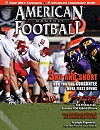Article CategoriesAFM Magazine
|
Zone Blitz Concepts – Defensive balance is the goal with all areas of the field covered when zone blitzing.by: Jason BornnHead Coach Saugus High School (CA) © More from this issue When talking about the zone blitz, it is imperative that some very basic concepts be understood. First, on all run plays, your seam defenders are the force defenders. It is their job to turn the ball back inside. Second, the QB should have only 2.7 seconds to throw the ball. If he has more time than that, you’re putting a lot of stress on your coverage players. Third, pass coverage must be clearly understood by all members of the defense. The most common form of coverage used when utilizing a zone blitz scheme is the three under, three deep concepts, in which the field is divided into six areas that need to be covered. Finally, for each call, gaps to be hit are assigned to defenders. Where they start and how they get there is entirely up to you. They key is that each member of the defense must understand who is in coverage and who/wh....The full article can only be seen by subscribers.
|
|
|||||||
| HOME |
MAGAZINE |
SUBSCRIBE | ONLINE COLUMNISTS | COACHING VIDEOS |
Copyright 2025, AmericanFootballMonthly.com
All Rights Reserved





